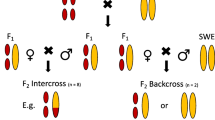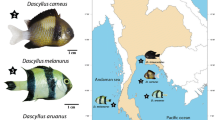Abstract
We examined the genomic occurrence of the transposable elementpogo in over 120 strains ofDrosophila melanogaster, from around the world and from different eras. All had multiple copies of a 2.1 kilobase (kb)pogo element, and multiple copies of several size classes between 1.0 and 1.8 kb. There were differences between strains in intensities or presences of deletion-derivative size classes, suggesting current or recent mobility in the species. We were unable to find anypogo-hybridization in eight other species in the genus, in three subgenera, or in the relatedScaptomyza pallida. Thepogo element may be a ‘middle-aged’ element in the genome ofD. melanogaster, having entered the species since its divergence from its sibling species, but long before theP andhobo elements.
Similar content being viewed by others
References
Anxolabéhère, D., M. G. Kidwell & G. Periquet, 1988. Molecular characteristics of diverse populations are consistent with the hypothesis of a recent invasion ofDrosophila melanogaster by mobileP elements. Molecular Biology and Evolution 5: 252–269.
Bingham, P. M., M. G. Kidwell & G. M. Rubin, 1982. The molecular basis of P-M hybrid dysgenesis: the role of the P element, a P-strain-specific transposon family. Cell 29: 995–1004.
Blackman, R. K. & W. M. Gelbart, 1989. The transposable elementhobo ofDrosophila melanogaster, pp. 523–529 in Mobile DNA, edited by D. E. Berg and M. M. Howe. American Society for Microbiology, Washington, D.C.
Boussy, I. A., M. J. Healy, J. G. Oakeshott & M. G. Kidwell, 1988. Molecular analysis of the P-M gonadal dysgenesis cline in eastern AustralianDrosophila melanogaster. Genetics 119: 889–902.
Boussy, I. A. & S. B. Daniels, 1991.hobo transposable elements inDrosophila melanogaster andD. simulans. Genetical Research 58: 27–34.
Coen, E. S., T. P. Robbins, J. Almeida, A. Hudson & R. Carpenter, 1989. Consequences and mechanisms of transposition inAntirrhinum majus, pp. 413–436 in Mobile DNA, edited by D. E. Berg and M. M. Howe. American Society for Microbiology, Washington, D.C.
Daniels, S. B., A. Chovnick & I. A. Boussy, 1990. Distribution of thehobo transposable element in the genusDrosophila. Molecular Biology and Evolution 7: 589–606.
Daniels, S. B., K. R. Peterson, L. D. Strausbaugh, M. G. Kidwell & A. Chovnick, 1990. Evidence for horizontal transmission of theP transposable element betweenDrosophila species. Genetics 124: 339–355.
Daniels, S. B. & L. D. Strausbaugh, 1986. The distribution of P-element sequences inDrosophila: thewillistoni andsaltans species groups. Journal of Molecular Evolution 23: 138–148.
Engels, W. R., 1989. P elements inDrosophila melanogaster, pp. 437–484 in Mobile DNA, edited by D. E. Berg and M. M. Howe. American Society for Microbiology, Washington, D.C.
Federoff, N. V., 1989. Maize transposable elements, pp. 375–411 in Mobile DNA, edited by D. E. Berg and M. M. Howe. American Society for Microbiology, Washington, D.C.
Finnegan, D. J., 1989. Eukaryotic transposable elements and genome evolution. Trends in Genetics 5: 103–107.
Finnegan, D. J., 1990. Transposable elements, pp. 371–384 in The genome ofDrosophila melanogaster, part 4, edited by D. L. Lindsley and G. Zimm. Drosophila Information Service 68.
Hanish, J. & M. McClelland, 1988. Activity of DNA modification and restriction enzymes in KGB, a potassium glutamate buffer. Gene Analysis Techniques 5: 105–107.
Hartl, D. L., 1989. Transposable elementmariner inDrosophila species, pp. 531–536 in Mobile DNA, edited by D. E. Berg and M. M. Howe. American Society for Microbiology, Washington, D.C.
Kidwell, M. G., 1985. Hybrid dysgenesis inDrosophila melanogaster: nature and inheritance of P element regulation. Genetics 111: 337–350.
Louis, C. & G. Yannopoulos, 1988. The transposable elements involved in hybrid dysgenesis inDrosophila melanogaster, pp. 205–250 in Oxford Surveys on Eukaryotic Genes, vol. 5, edited by N. MacLean. Oxford, New York.
Maniatis, T., E. F. Frisch & J. Sambrook, 1982. Molecular Cloning: A Laboratory Manual. 545 pp. Cold Spring Harbor Laboratory, New York.
McClelland, M., J. Hanish, M. Nelson & Y. Patel, 1988. KGB: a single buffer for all restriction endonucleases. Nucleic Acids Research 16: 364.
Moerman, D. G. & R. H. Waterston, 1989. Mobile elements inCaenorhabditis elegans and other nematodes, pp. 537–556 in Mobile DNA, edited by D. E. Berg and M. M. Howe. American Society of Microbiology, Washington, D.C.
O'Hare, K., M. R. K. Alley, T. E. Cullingford, A. Driver & M. J. Sanderson, 1991. DNA sequence of the Doc retroposon in thewhite-one mutant ofDrosophila melanogaster and of secondary insertions in the phenotypically altered derivativeswhite-honey andwhite-eosin. Molecular and General Genetics 225: 17–24.
O'Hare, K. & G. M. Rubin, 1983. Structures of P transposable elements and their sites of insertion and excision in theDrosophila melanogaster genome.Cell 34: 25–35.
Pascual, L. & G. Periquet, 1991. Distribution ofhobo transposable elements in natural populations ofDrosophila melanogaster. Molecular Biology and Evolution 8: 282–296.
Periquet, G., M. Hamelin, Y. Bigot & K. Hu, 1989a. Presence of the deletedhobo elementTh in Eurasian populations ofDrosophila melanogaster. Génétique, Sélection et Évolution 21: 107–111.
Periquet, G., M. H. Hamelin, Y. Bigot & A. Lepissier, 1989b. Geographical and historical patterns of distribution ofhobo elements inDrosophila melanogaster populations. Journal of Evolutionary Biology 2: 223–229.
Períquet, G., M. H. Hamelin, R. Kalmes & J. Eeken, 1990.Hobo elements and their deletion-derivative sequences inD. melanogaster and its sibling speciesD. simulans, D. mauritiana andD. sechellia. Génétique, Sélection et Évolution 22: 393–402.
Stacey, S. N., R. A. Lansman, H. W. Brock & T. A. Grigliatti, 1986. Distribution and conservation of mobile elements in the genusDrosophila. Molecular Biology and Evolution 3: 522–534.
Streck, R. D., J. E. MacGaffey & S. K. Beckendorf, 1986. The structure of hobo transposable elements and their insertion sites. EMBO Journal 5: 3615–3623.
Tudor, M., M. Lobocka, M. Goodell, J. Pettitt & K. O'Hare, 1992. The pogo transposable element family ofDrosophila melanogaster. Molecular and General Genetics 232: 126–134.
Author information
Authors and Affiliations
Rights and permissions
About this article
Cite this article
Boussy, I.A., Charles, L., Hamelin, M.H. et al. The occurrence of the transposable elementpogo inDrosophila melanogaster . Genetica 88, 1–10 (1993). https://doi.org/10.1007/BF02424447
Received:
Accepted:
Issue Date:
DOI: https://doi.org/10.1007/BF02424447




